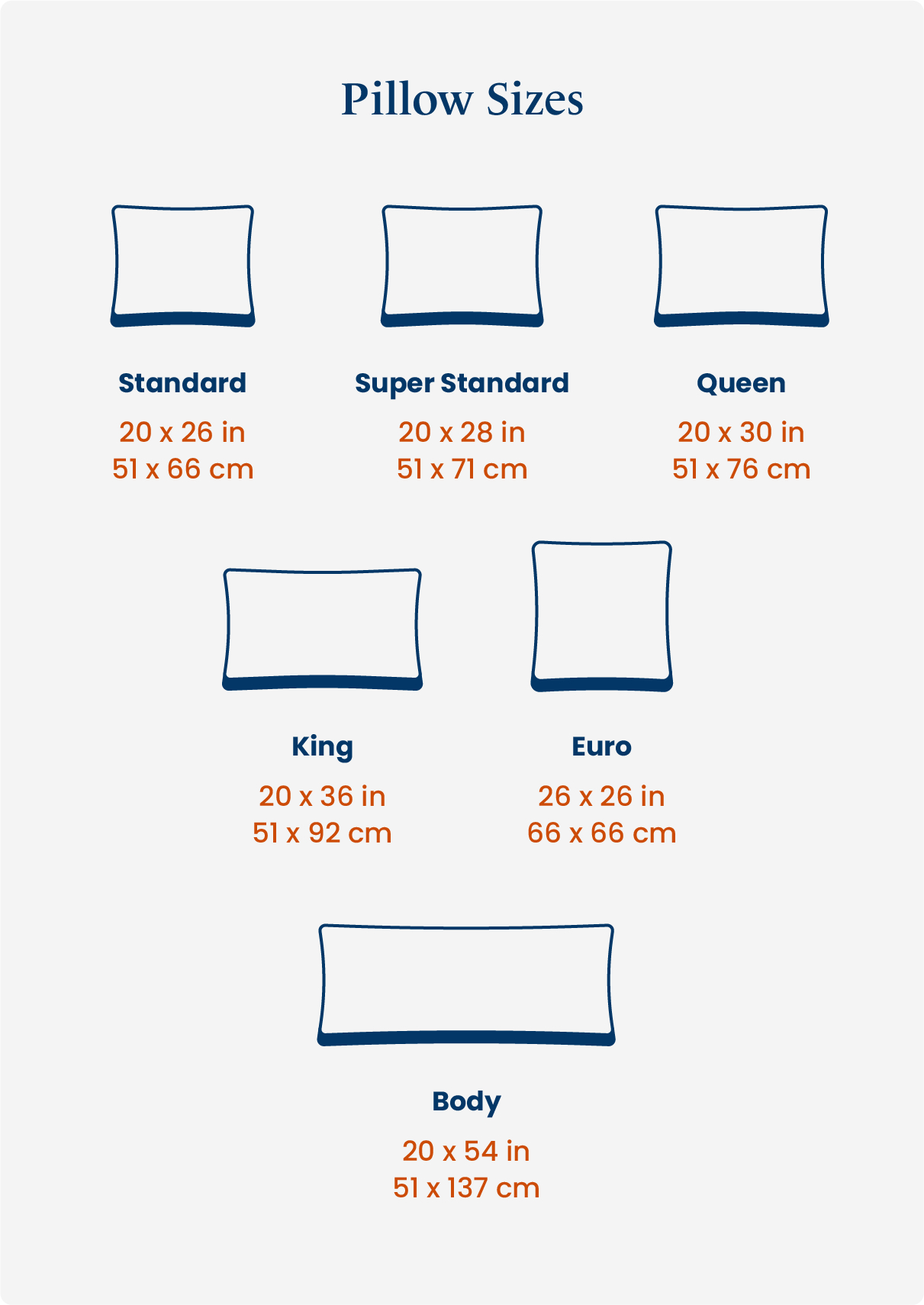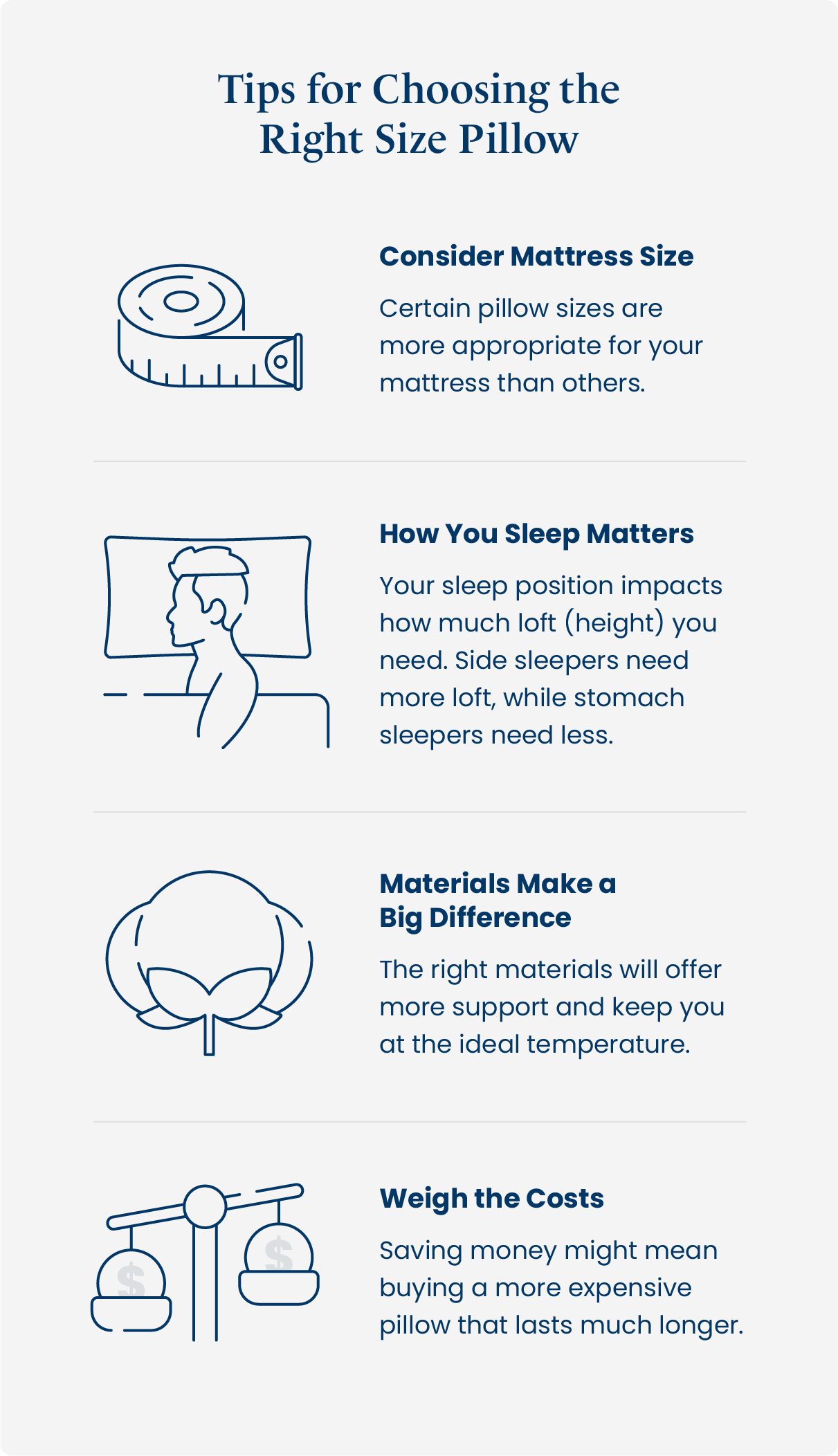Ever tossed and turned all night and wondered why you can’t get to sleep or stay asleep? It could mean you’re using the wrong pillow. Everything from the pillow dimensions to its material could be making your sleep worse. Understanding where your pillow falls on a pillow size chart and how that can impact your sleep is the first step to finding a better pillow.
Let’s take a look at different pillow sizes, how to measure a pillow, and tips for choosing the right pillow to get the best night of sleep possible.
Pillow Dimensions Chart
While decorative pillows may come in almost any size and shape you can imagine, the pillows we use to sleep on are (mostly) rectangular and linked to mattress size. Let’s look at the most common pillow sizes from smallest to largest and which ones will fit best on your mattress.

| Pillow and Pillowcase Sizes | ||
|---|---|---|
| Standard | 20 x 26 inches | 51 x 66 centimeters |
| Super Standard | 20 x 28 inches | 51 x 71 centimeters |
| Queen | 20 x 30 inches | 51 x 76 centimeters |
| King | 20 x 36 inches | 51 x 92 centimeters |
| Euro | 26 x 26 inches | 66 x 66 centimeters |
| Body | 20 x 54 inches | 51 x 137 centimeters |
Standard Pillow
Dimensions: 20 x 26 inches
Best for: Adults and children; twin, twin XL, and full mattresses
The standard pillow is the most common size. While it can work on any size mattress, it’s just right for twin and twin XL mattresses. Two standard pillows will fit perfectly on a full size mattress. Use standard or super standard pillowcases for pillows this size.
Super Standard Pillow
Dimensions: 20 x 28 inches
Best for: Adults and children; twin, twin XL, and full mattresses
The super standard gives you a pillow a little bigger than a standard and a little smaller than a queen. You can fit one super standard on a twin, twin XL, or full mattress or two on a queen mattress. These pillows use a super standard or queen pillowcase.
Queen Pillow
Dimensions: 20 x 30 inches
Best for: Adults and children; twin, twin XL, full, or queen mattresses
Queen pillow dimensions are longer than a super standard pillow by 2 inches. Two queen pillows will fit perfectly on a queen mattress, or you can use a single queen on a twin, twin XL, or full mattress. A queen pillow needs a queen or king size pillowcase.
King Pillow
Dimensions: 20 x 36 inches
Best for: Adults; queen, king, or California king mattresses
King size pillows are 6 inches longer than queen pillows. If you move around a lot while you sleep, the king size pillow dimensions give you the extra room you need. Two king pillows can fit on a king mattress. A king size pillow needs a king size pillowcase.
Euro Pillow
Dimensions: 26 x 26 inches
Best for: Relaxing activities, decoration; any mattress size
Euro pillows are different from other pillows because they’re square. They’ll fit on any size mattress but are most useful as decoration or for extra support when you’re sitting up in bed. They require Euro size pillowcases.
Body Pillow
Dimensions: 20 x 54 inches
Best for: Pregnant people; those with back, hip, or knee pain
Body pillows are the longest pillows available and provide sleepers with health benefits that other pillows may not offer. These pillows come in different shapes that allow for multiple comfortable positions. Experts recommend using body pillows for a number of reasons, like between your legs at night to help improve circulation and spinal alignment and reduce soreness.
How To Measure a Pillow
Most pillows have their size printed on the tag, but if you have older pillows or the tags are gone, there is an easy way to measure a pillow to find out what size pillowcases to order. Here’s how:
- Lay the pillow on a flat surface.
- Smooth out the pillow so the filling is evenly distributed.
- Using a tape measure, measure the top edge and a side edge.
How To Choose a Pillow Size: Key Considerations
Finding the right pillow isn’t as easy as just grabbing the first one you see. When you’re buying pillows, it’s important to consider mattress size, sleeping position, pillow materials, and cost before you make a decision. Let’s take a look at these factors in more depth so that when it’s time to change your pillow, you can find the best fit for you.

Mattress Size
There’s nothing wrong with using smaller pillows on larger mattresses. In fact, having three standard pillows on a king or California king might give you more options for getting comfortable than just two pillows.
As mattress size increases, getting larger pillows makes moving around at night easier and more comfortable for many people. Pillows that are sized to fit a mattress also look better.
Using a pillow that is too big for your mattress won’t look great and may be uncomfortable because it could hang off the edge of the bed and even end up on the floor.
Sleeping Position
Your sleep position is one of the most important factors in choosing a pillow size. Many pillow manufacturers add more filling in their pillows as they size up, increasing the loft (or height) — but this isn’t ideal for a good night’s sleep if you prefer certain sleep positions.
- If you’re a side sleeper, a higher loft pillow designed for side sleepers can keep your neck and spine aligned for a more comfortable sleeping position.
- For stomach sleepers, a low loft pillow will make sleeping more comfortable because it will keep your neck aligned more naturally. Using thicker pillows could leave stomach sleepers waking up feeling stiff or sore.
- Back sleepers have the most flexibility when it comes to loft, so try out several thicknesses to find the pillow that is just right for you.
When you’re thinking about getting a new pillow, lie on it in your normal sleeping position and see if it feels good. You shouldn’t notice any uncomfortable or unnatural angles in your neck or spine, and if you sleep on your side or stomach, you don’t want the pillow to wrap around or cover your mouth and nose. If you’re pregnant and have body aches and pains, a body pillow that keeps you in a more comfortable position could really change how well you sleep.
Material
What your pillow is made of is about more than just comfort — it can have a direct impact on how well you sleep at night. Here are a few of the ways pillow material impacts your sleep:
- Support and pressure relief: Memory foam pillows mold to your head and neck to reduce pressure points and provide support for nearly any position. Other materials like polyfill are less adaptive, which can be great for stomach sleepers who need flatter pillows.
- Temperature regulation: If you get hot when you sleep, breathable and moisture-wicking materials like latex or buckwheat hulls can keep you cooler at night. Down and feather pillows tend to trap heat, as do many kinds of memory foam, so take that into account to avoid buying the wrong pillow for your ideal sleeping temperature.
- Noise and movement: When sharing a bed, movement and sound can be a big concern. Materials like memory foam or down tend to absorb movement and minimize noise disruption.
Cost
Bigger definitely means pricier when it comes to pillows. King size pillows require more filling, naturally pushing the price up compared to standard or queen sizes. Material also plays a major role — natural fillings like down and wool, along with certain synthetic materials like memory foam, are more expensive than options like polyfill.
But cost isn't just about size and raw materials. More expensive pillows are generally constructed better, meaning they last longer. When a good pillow lasts significantly longer than a cheaper one, you actually end up saving money. Investing in your sleep is one of the best ways to invest in your overall health.






















